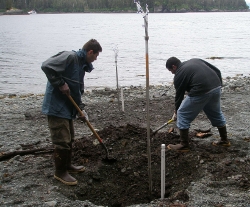Low concentrations of oxygen and nutrients slowing biodegradation of Exxon Valdez oil
| A study led by Temple’s Michel Boufadel has garnered national attention for its analysis of the biodegradation of oil concentrations trapped in the beaches of Alaska's Prince William Sound some 20 years after the Exxon Valdez oil spill.
Published this week in the journal Nature Geoscience, the study found that low concentrations of oxygen and nutrients are hindering micro-organisms from biodegrading the oil. Reports on the study, titled “Long-term persistence of oil from the Exxon Valdez spill in two-layer beaches,” have appeared in the New York Times, Associated Press, Reuters, Agence France-Presse, Los Angeles Times, NPR, BBC, ABCNews.com, Scientific American, the Anchorage Daily News and many other news outlets. |
 Courtesy: Michel Boufadel
Temple engineering students dig a well in a beach on Alaska's Prince William Sound during
the summer of 2008. A Temple-led study found that compacted sediment beneath the surface of the sound's beaches has slowed the biodegradation of the oil that remains from the Valdez spill |
|
Considered one of the worst environmental disasters in history, the Valdez spilled more than 11 million gallons of crude oil, contaminating some 1,300 miles of shoreline, killing wildlife and severely impacting Alaska’s fishing industry and economy. In the first five years after the accident, the oil was disappearing at a rate of about 70 percent and calculations showed it would be gone within the next few years. However, about seven or eight years ago it was discovered that the oil had in fact slipped to a disappearance rate of around four percent a year and it is estimated that nearly 20,000 gallons of oil remain in the beaches. Led by Boufadel, Civil and Environmental Engineering chair and director of the Center for Natural Resources Development and Protection in Temple’s College of Engineering, Temple researchers have been studying the cause of the remaining oil for the past three years. Boufadel said the beaches they studied consisted of two layers: an upper layer that is highly permeable and a lower layer that has very low permeability. He said that, on average, water moved through the upper layer up to 1,000 times faster than the lower layer, and while both layers are made up of essentially the same materials, the lower layer has become more compacted through the movement of the tides over time. These conditions, said Boufadel, have created a sort of sheltering effect on the oil, which often lies just 1-4 inches below the interface of the two layers. Boufadel said that oxygen and nutrients are needed for the survival of micro-organisms that eat the oil and aid in aerobic biodegradation of the oil. But without the proper concentrations of nutrients and oxygen along with the slow movement of water, anaerobic biodegradation is probably occurring, which is usually very slow. Boufadel said that an earlier study, published in 1994, had already established that a low concentration of nutrients was affecting the remaining Exxon Valdez oil. He said that because of Alaska’s pristine environment, you would expect to find a low concentration of nutrients and this recent study confirmed the earlier findings. What Boufadel and his team found was, on average, that the nutrient concentration in the beaches was 10 times lower than what is required for optimal aerobic biodegradation of oil. They also found that the oxygen levels in the beaches are insufficient to sustain aerobic biodegradation. Using groundwater hydraulic studies, the researchers found that the net movement of water through the lower layer of beach was outward, so it is preventing oxygen from diffusing through the upper layer to where the oil is located. “You have a high amount of oxygen in the seawater, so you would like to think that the oxygen would diffuse in the beach and get down two to four inches into the lower layer and get to the oil,” said Boufadel. “But the outward movement of the water in the lower level is blocking the oxygen from spreading down into that lower layer.” Boufadel and his team are now exploring ways to deliver the much needed oxygen and nutrients to the impacted areas in an effort to spur aerobic biodegradation of the remaining oil. The study was funded by a grant from the Exxon Valdez oil Spill Trustee Council. |
|